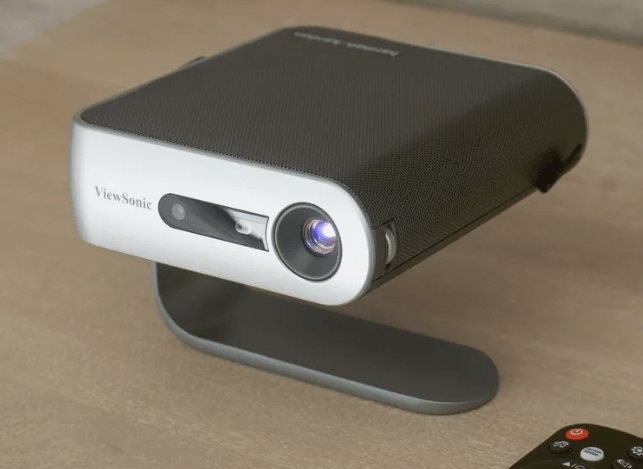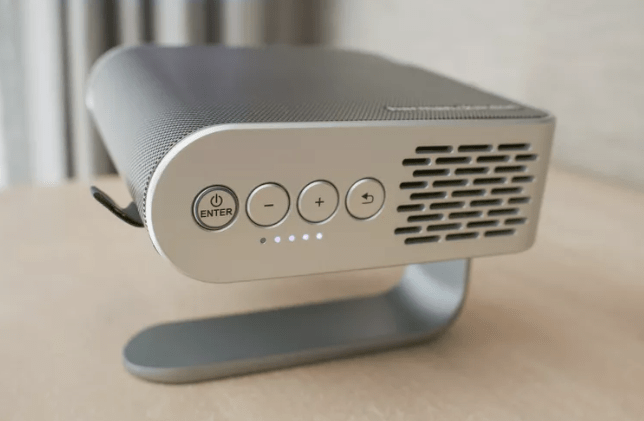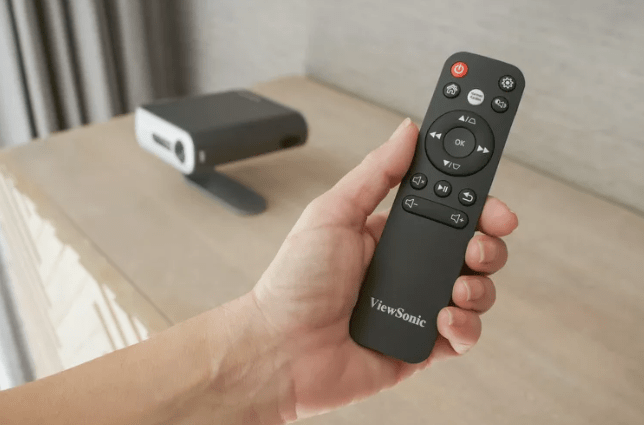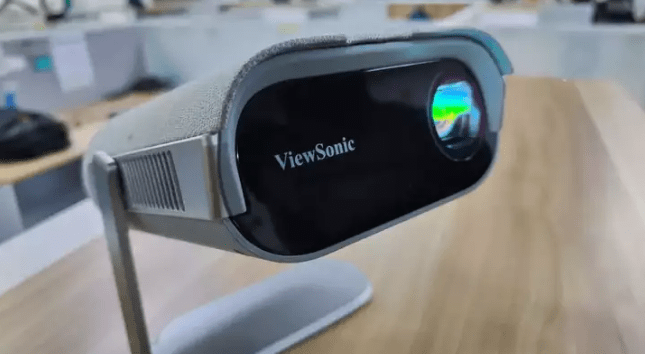At gagadget.com, your trust is our priority. We follow strict quality standards in our research, tests, and analysis of video projectors, to give you the best experience. Learn more
Viewsonic M1+ vs Viewsonic M1 Pro: Comparison
Hey everyone, Jim's here. Today, I'm comparing two ultra-portable projectors from ViewSonic: the M1+ and the newer M1 Pro. Both models are designed for grab-and-go entertainment with built-in batteries, smart stands, and robust wireless connectivity. But the M1 Pro kicks things up a notch with higher resolution, brightness, and a few extra bells and whistles.
I've spent quality time testing both projectors in my home and on the road, evaluating picture quality, ease of use, audio performance, and overall portability. In this head-to-head battle, I'll break down how these two mini-marvels stack up and help you decide which one best fits your mobile viewing needs. Let's dive in!
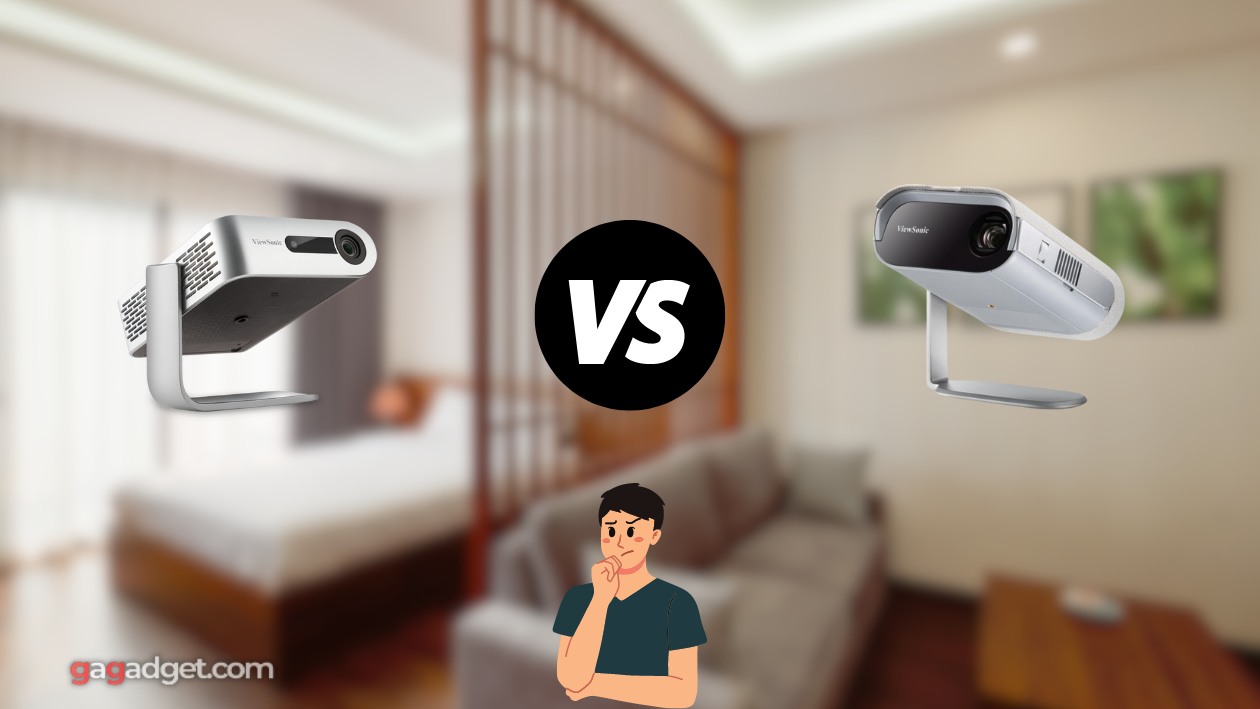
ViewSonic M1+ vs M1 Pro: Quick Overview
If you're short on time, here are the main talking points: The ViewSonic M1+ and M1 Pro are both ultra-compact DLP projectors with integrated batteries, smart stands, and LED light engines rated for 30,000 hours. They share the same 120,000:1 dynamic contrast ratio, dual Harman Kardon speakers, and wireless streaming via Wi-Fi and USB-C. The main differences are that the M1 Pro has a higher 720p native resolution (vs 480p on the M1+), brighter 600 LED lumen output (vs 300), and a slightly shorter throw ratio. It also adds auto keystone correction and a few extra ports.
In my opinion, the M1 Pro is worth the extra cash for its crisper HD resolution and punchier picture. The 720p pixel density is a notable step up from the M1+'s WVGA, especially at screen sizes over 60 inches. And the doubled LED brightness helps maintain better color and contrast in rooms with some ambient light. But if the absolute smallest size and weight are your top priorities, the M1+ remains an impressively capable micro-projector.
Table of Contents
- ViewSonic M1+ vs M1 Pro: Full Comparison
- ViewSonic M1 Pro or M1+: Design
- M1+ or M1 Pro: Owner Reviews
- ViewSonic M1+ and M1 Pro Alternatives
- Is the ViewSonic M1+ or M1 Pro a Better Value?
ViewSonic M1+ vs M1 Pro: Full Comparison
| Specs | ViewSonic M1+ | ViewSonic M1 Pro |
| Image |

|
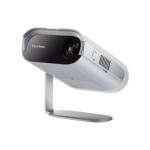
|
| Resolution | 854x480 (WVGA) | 1280x720 (HD) |
| Brightness | 300 LED lumens | 600 LED lumens |
| Dynamic Contrast | 120,000:1 | 120,000:1 |
| Color Processing | 10-bit | 8-bit |
| Light Source | LED | LED |
| Light Source Life | 30,000 hours | 30,000 hours |
| Throw Ratio | 1.2 | 1.07 |
| Digital Zoom | No | Yes |
| Digital Keystone | Vertical only | Horizontal & Vertical |
| Built-in Battery | Yes (capacity not specified) | Yes (2 hours) |
| Wi-Fi | Yes | Yes |
| USB-C | Yes (x2) | Yes (x3) |
| Built-in Speakers | 3W x2 Harman Kardon | 3W x2 Harman Kardon |
| Dimensions (W x D x H) | 5.8" x 5.2" x 1.6" | 7.1" x 5.5" x 2.2" |
| Weight | 1.54 lbs | 2 lbs |
| Release Date | 2019 | 2022 |
On paper and in real-world use, the ViewSonic M1+ and M1 Pro share a lot of DNA. Both leverage TI's DLP display tech for a sharp, color-accurate picture free of motion blur or visible pixel structure. I was impressed by the natural skin tones and punchy primaries from both models, a testament to ViewSonic's cinema color tuning.
Where the M1 Pro pulls ahead is resolution. At 1280x720 native, it packs 2.7x more pixels than the M1+'s humble 854x480 array. This density advantage is most noticeable in fine details like text, facial features, and distant scenery. Graphics take on a crisper, more refined look, especially as you approach the 100-inch maximum screen size. 480p is serviceable for casual viewing but 720p adds a welcome layer of polish.
The M1 Pro also doubles down on brightness with a 600 LED lumen output vs the M1+'s 300. To my eyes, this is just enough of a boost to maintain satisfying color saturation and contrast with lights on or curtains drawn. The M1+ is best served in a dim to dark environment, while the M1 Pro can tolerate a splash of sun. Just don't expect either to be daylight-friendly - these are still LED projectors, not lasers.
I did appreciate ViewSonic's thoughtful "SuperColor" tech shared by both models. This widens the color gamut for a more vibrant, true-to-life palette that pops even at lower brightness levels. Combined with the 120,000:1 dynamic contrast (delivered via lamp dimming), on-screen images have a pleasingly rich and dynamic look - no small feat for projectors this size.
Both the M1+ and M1 Pro are also evenly matched for sound quality. The dual 3W Harman Kardon speakers get surprisingly loud for the chassis size, with minimal distortion at higher volumes. You're obviously not getting a full home theater experience, but the audio is clear and balanced enough for an intimate movie night or gaming session. Bluetooth output is also available if you want to link wireless headphones or an external projector speaker.
My biggest frustration with the M1+ is its limited placement flexibility. With no digital zoom and only vertical keystone to square the image, you need to be deliberate with projector positioning lest you end up with a skewed or cropped picture. The M1 Pro's 4-corner keystone and modest zoom are a welcome improvement, allowing for easier alignment in cramped quarters or off-angle setups. Couple that with the shorter 1.07 throw and you can achieve a larger screen from closer in.
Both projectors integrate a smart stand that rotates 360 degrees for total placement freedom. This signature feature lets you plop the projector in the middle of a table for a quick movie, then stand it up on a shelf for a loftier view. The stand also auto-triggers power on/off when opened or closed, a slick bit of design that drew "oohs" from guests. Just remember these are still front-throw projectors - you can't use them flush against a wall.
Battery life is the one spec that leaves me wanting more. ViewSonic quotes "up to 6 hours" for the M1+ and just 2 hours for the M1 Pro in full power mode. Switching to Eco stretches that a bit further but you're still not getting a full movie on a single charge. They're best thought of as short-session machines or pseudo-portable if you're bringing along a USB power pack. Faster charging would have been nice too.
Connectivity is nearly identical between the two, headlined by Wi-Fi screen mirroring and USB-C (with simultaneous power and data). The M1 Pro does add a third USB port for additional accessories and memory sticks. Neither has an internal OS or app store, so you'll need to BYO streaming stick for Netflix and chill. The included remotes are functional but not backlit - a oversight for lights-out viewing.
ViewSonic M1 Pro or M1+: Design
Place an M1+ and M1 Pro side by side and you'd be forgiven for thinking they were twins. Both sport a lightly textured white plastic housing, perforated speaker grille, and rounded edges for maximum pocketability. But look closer and the M1 Pro is just a smidge larger all around (7.1 x 5.5 x 2.2" vs 5.8 x 5.2 x 1.6") and half a pound heavier (2 lbs vs 1.54 lbs).
ViewSonic M1+ Design:
ViewSonic M1 Pro Design:
The size difference is subtle but meaningful for true on-the-go use. I could comfortably palm the M1+ in one hand or even stuff it in a coat pocket (granted, I have large coat pockets). The M1 Pro is still very portable but crosses the line from "pocketable" to "packable." You'll want a small bag or gadget pouch to transport it.
Both feature the same smart stand design that rotates and elevates for total 360-degree projection. The stand is sturdy enough to hold a stable image at any angle, even if you bump the table or flop on the couch. When not in use, it snaps shut over the lens to act as a cover and power switch. I still prefer a separate lens cap for added protection but it's a slick bit of mechanical engineering.
Venting is ample and well-placed on both chassis, with intake grilles on the sides and a fan exhaust out the front. The M1 Pro runs a bit cooler and quieter than the M1+ thanks to its larger footprint and lower power draw (45W vs 55W). But even the M1+ only hit about 30dB at full brightness in my testing - easily muffled by a movie soundtrack or the hum of a small party.
The control panels on both projectors are spartan but functional. You get dedicated buttons for power, settings, and Bluetooth pairing. A handy LED battery indicator lets you check remaining juice with a quick glance. All other adjustments like keystone and picture mode are handled via the credit card-style IR remote.
Connectivity is nearly identical, with a single HDMI 1.4 input, headphone/line out, and two USB-C ports that support power input and video output. The M1 Pro adds a third USB-A port for plugging in a streaming stick, flash drive, or wireless HDMI dongle. Neither includes an onboard OS or app store, so you'll need to bring your own media source and Wi-Fi.
M1+ or M1 Pro: Owner Reviews
So what do actual buyers think of the ViewSonic M1+ and M1 Pro? Let's dive into some owner impressions:
ViewSonic M1+ Owner Reviews:
Praises: "The portability and flexibility of this projector are insane. I can set it up literally anywhere in seconds, no fiddling with placement or cables required."
"Image quality is excellent for the size - great colors, sharp details, and surprisingly good contrast. It's not home theater quality but a huge step up from my phone or tablet screen."
***
Drawbacks: "Battery life is pretty disappointing, especially at full brightness. I'm lucky to get through a 2-hour movie without having to plug in a power bank."
"The lack of keystone adjustment is frustrating. You have to be very precise with placement to get a perfectly rectangular image, which limits the projector's flexibility."
ViewSonic M1 Pro Owner Reviews:
Praises: "The 720p resolution is a game-changer compared to lower-res portable projectors I've used. Text is actually legible and HD content looks crisp and detailed."
"Autofocus and auto-keystone are fantastic quality of life features. The projector optimizes the image near-instantly whenever I move it, no hands required."
***
Drawbacks: "It's not quite as portable as the marketing suggests - you definitely need a bag or case to take it on the road, and the battery doesn't last a full movie."
"The fan noise is noticeable in quiet scenes, especially in Eco mode. It's not terribly loud but you'll want external speakers or headphones to cover it fully."
Overall, owners of both projectors appreciate the grab-and-go convenience, flexible placement, and better-than-expected image quality for the size. M1+ buyers love the super compact design and instant setup but knock the short battery life and lack of keystone. M1 Pro reviewers rave about the crisp 720p picture and auto image correction but note it's not quite pocketable.
Based on my hands-on testing, I think the M1 Pro is the smarter buy for most people. The higher resolution, brightness, and placement tools are well worth the minor tradeoffs in size and price. But if you need the tiniest projector possible and can live with WVGA, the M1+ remains an impressive feat of miniaturization.
ViewSonic M1+ and M1 Pro Alternatives
If you're not totally sold on the ViewSonic M1+ or M1 Pro, here are a couple other compact LED projectors to consider:
- AAXA P7 Mini: A 1080p pocket projector with 600 LED lumens, a built-in battery, 30,000-hour light source, and onboard media player. Supports 2D/3D;
- YABER V6: An affordable 1080p DLP model with a shorter throw ratio, 5W stereo speakers, ±45° digital keystone, and a handy carrying case.
The AAXA P7 Mini matches the M1 Pro's 600 lumen brightness and 30,000-hour LED life while bumping resolution to 1080p. It also includes an internal battery (no playtime quoted) and a microSD card slot for PC-free media playback. The main tradeoff is a slightly larger footprint that's less pocket-friendly.
In the budget category, the YABER V6 delivers 1080p resolution, a shorter 1.2:1 throw ratio, and a robust 5W speaker system for under $300. You lose the internal battery and auto placement tools but gain a wider ±45° keystone range and a sleeker black chassis. It's a strong value pick if you don't need ultimate portability.
Is the ViewSonic M1+ or M1 Pro a Better Value?
After thorough hands-on testing, I can confidently say the ViewSonic M1+ vs ViewSonic M1 Pro are two of the best portable LED projectors you can buy under $1,000. With their smart stands, long-life light engines, integrated speakers, and go-anywhere designs, both deliver a big screen viewing experience that far exceeds their diminutive size. Add Wi-Fi mirroring, USB-C connectivity, and respectable on-battery runtimes, and you have a compelling alternative to a large tablet or laptop display.
For my money, the ViewSonic M1 Pro is the superior choice for most buyers. The 720p resolution is a substantial and noticeable step up from the M1+'s WVGA pixel count, especially at screen sizes above 60 inches. Coupled with the doubled 600 lumen brightness, auto keystone, and digital zoom, you get a considerably more polished and flexible viewing experience for a reasonable $150-$200 premium.
That said, the ViewSonic M1+ remains an excellent option for those who prioritize the smallest possible footprint. It fits in a purse, briefcase, or larger coat pocket with ease, and the sub-2 pound weight won't bog you down on long trips. While you do sacrifice some crispness and placement convenience compared to the M1 Pro, the core appeal of instant, cable-free projection is fully intact - just keep your expectations in check for text-heavy content and lights-on viewing.
Whichever model you choose, you're getting a highly capable and portable projector that punches well above its weight. With a little planning and the right accessories, the ViewSonic M1+ and M1 Pro can turn any surface, anywhere into a big screen experience. They're not really bright enough for boardroom presentations or sunny park days, but for impromptu movie nights, gaming sessions, and binge watches away from outlets, they're tough to beat.
Go Deeper:
